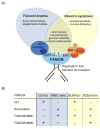FANCM: A landing pad for the Fanconi Anemia and Bloom's Syndrome complexes
- PMID: 20064455
- PMCID: PMC2830608
- DOI: 10.1016/j.molcel.2009.12.007
FANCM: A landing pad for the Fanconi Anemia and Bloom's Syndrome complexes
Abstract
In this issue of Molecular Cell, Deans and West (2009) reveal the molecular basis of the phenotypic similarities between Fanconi Anemia (FA) and Bloom's Syndrome, identifying FANCM as the anchor for both FA and Bloom's complexes at the site of the DNA interstrand crosslink.
2009 Elsevier Inc.
Figures

Comment on
-
FANCM connects the genome instability disorders Bloom's Syndrome and Fanconi Anemia.Mol Cell. 2009 Dec 25;36(6):943-53. doi: 10.1016/j.molcel.2009.12.006. Mol Cell. 2009. PMID: 20064461
References
Publication types
MeSH terms
Substances
Grants and funding
LinkOut - more resources
Full Text Sources

